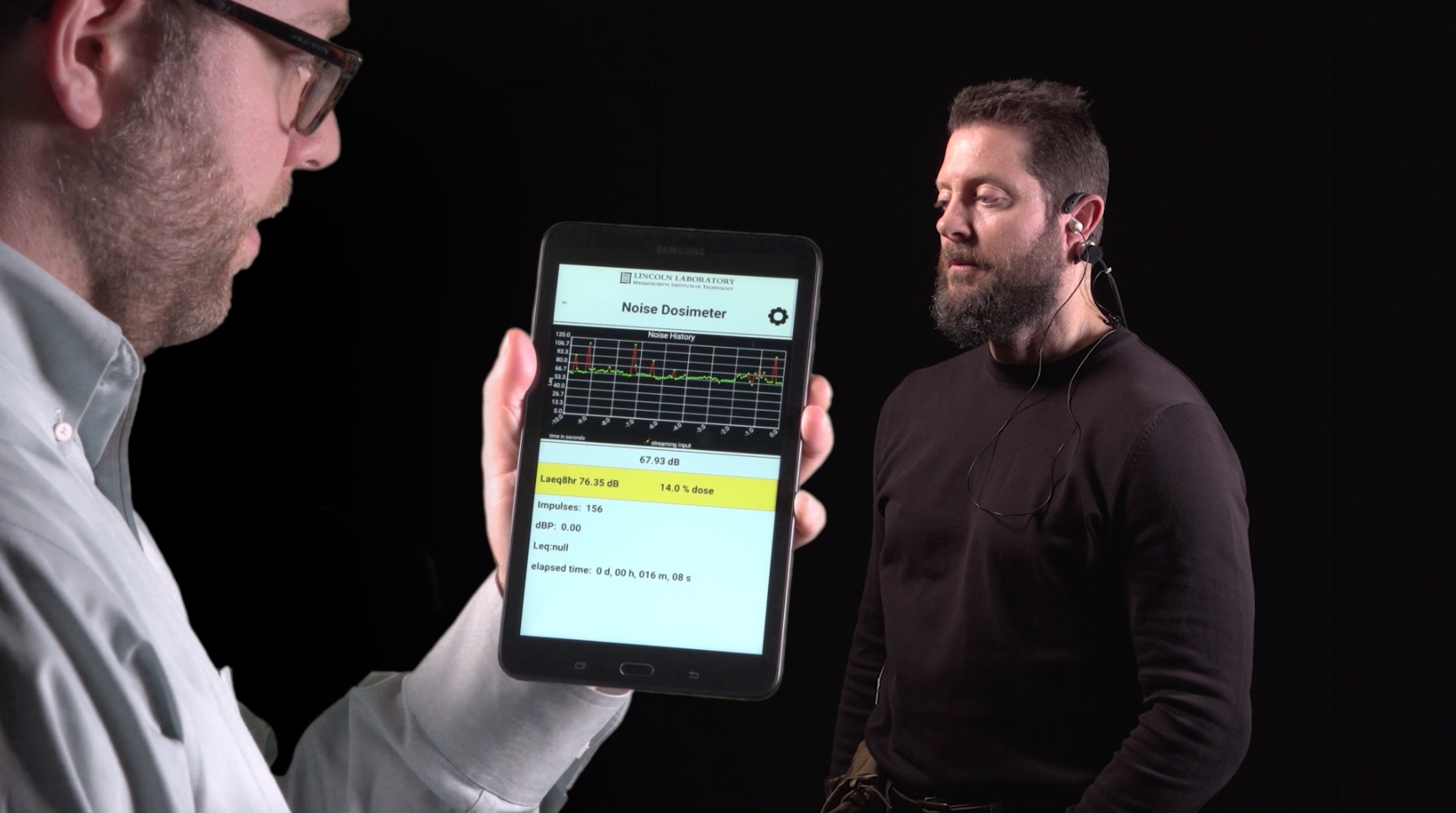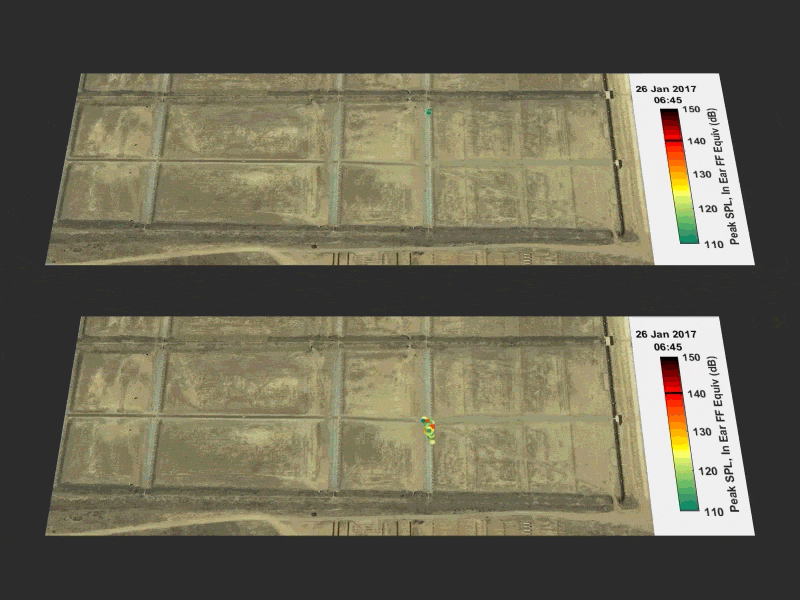
New noise monitor helps protect warfighters from hearing loss

What do a bomb, a drill, and a lawn mower have in common? All are occupational hazards that emit noise at levels that can be harmful to one's hearing. Approximately 36 million people in the United States suffer from hearing loss, and one in three people suffers hearing loss because of exposure to detrimental noise levels. Hearing protection devices exist, but they are often worn or used incorrectly by users who find that the devices are uncomfortable and reduce their situational awareness.
The Monitoring Noise On-Body and In-Ear for Serviceperson Exposures (MNOISE) device, developed by a team of Lincoln Laboratory researchers, records noise levels, assesses the severity of those levels, and alerts users if they are being exposed to harmful noise. The device aims to enable hearing-loss intervention and identify issues with the fit of hearing protection devices worn by warfighters and laborers.
"Our noise-dosimeter technology was developed to help decrease the number of people who suffer hearing loss caused by overexposure to high levels of noise," said Christopher Smalt, who leads data collection and analysis for MNOISE and is a member of the Bioengineering Systems and Technologies Group at Lincoln Laboratory. Smalt and team members began working on MNOISE in 2013, using noise-exposure data collected from warfighters during tactical military operations in Afghanistan.
MNOISE monitors noise levels by using on-body and in-ear components. Individuals wear a walkie talkie–sized electronic device and microphone on their body and a second, small headphone-like microphone in their ear. Both components sense the noises that users are exposed to and feed the data into processing algorithms. These algorithms calculate exposure metrics, such as peak sound pressure and total energy, and use computational models of the inner ear to predict damage. After the information has been automatically processed and assessed, the metrics are sent to the user's smart phone or tablet in the form of an exposure score. This score alerts users when the noise they are experiencing is approaching an exposure threshold that is above what is deemed safe by the organizations that set military and occupational health standards.
The in-ear microphone of MNOISE is embedded inside a reusable hearing protection device, similar to a standard foam earplug. The advantage of integrating MNOISE technology with a hearing protection device is that it can alert users if their hearing protection is improperly fit or inadequately protecting them. This warning is calculated by subtracting the sound level recorded by the in-ear microphone from the sound level recorded by the external microphone on the body. If the difference falls below the protective decibel level that the device is designed to meet, then the device is not being worn properly or is insufficient for that environment. This in-ear measurement capability was developed with funding from the Office of Naval Research's Noise-Induced Hearing Loss program.
The process of recording, processing, analyzing, and alerting happens in real time to provide users with information that they can use to protect their hearing. For instance, consider a construction worker who was exposed to a blast noise during a demolition project. Immediately after the incident, a construction worker could visit an audiologist or industrial hygienist, who can assess the worker's peak levels and noise exposure data and suggest corrective actions to prevent further hearing loss. MNOISE exposure metrics can also be used to help improve the design of hearing protection devices by identifying situations in which the user is either over- or underprotected.
The Laboratory team finds that MNOISE is a significant improvement over commercial off-the-shelf (COTS) noise monitors because it captures a wider range of noise levels and can measure the exposure closer to the source of injury. COTS monitors can only accurately measure continuous noises like machine or engine noise, for example. These noise monitors are unable to characterize low-level blast overpressures or impulse noises, such those caused by grenades or small-weapons fire. By contrast, MNOISE's large dynamic range allows it to record all three types of noises — continuous, blast-related, and impulse — making this technology particularly useful in training or combat environments.
Also useful is MNOISE's ability to respond to the variations in noise exposure that happen as a result of movement or changes in the surrounding environment. For example, consider a warfighter who is using MNOISE to monitor noise exposure during marksmanship training at a gun range. As the warfighter and other trainees move around the range, the spatial relationships between the warfighter and the trainees' weapons change in terms of distance and orientation. The placement of the MNOISE sensors on the body and in the ear maximizes the ability to capture the direction-dependent characteristics of the exposure and to compute an accurate noise exposure level.

"Noise exposure can vary from individual to individual depending on the sources of noise and location of those exposed individuals in relation to the noise sources. MNOISE looks to capture the noise exposure of individuals and then relate that exposure to existing and newly developing hearing-loss models," said Joseph Lacirignola, who led the hardware development of MNOISE and is a member of the Laboratory's Chemical and Biological Defense Systems Group.
Using the data collected from MNOISE, researchers from Lincoln Laboratory have proposed improvements in the way exposure risk is measured and calculated for the warfighter. Smalt is currently serving as a subject-matter expert for the Department of Defense to help refine military impulse noise and blast injury health standards for the auditory system.
While MNOISE was originally developed as part of a military contract to protect warfighters in the line of duty, the technology can also help industrial workers for whom noise is an occupational hazard. Smalt said that his team will continue their involvement with MNOISE as it reaches new stages of development. "The technology is in the process of being transitioned to industry, with the end goal that they might develop a commercially available product," he said.
